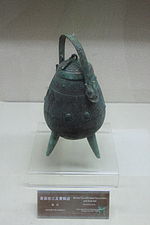
A teapot is a vessel used for steeping tea leaves or a herbal mix in boiling or near-boiling water, and for serving the resulting infusion which is called tea. It is one of the core components of teaware. Dry tea is available either in tea bags or as loose tea, in which case a tea infuser or tea strainer may be of some assistance, either to hold the leaves as they steep or to catch the leaves inside the teapot when the tea is poured. Teapots usually have an opening with a lid at their top, where the dry tea and hot water are added, a handle for holding by hand and a spout through which the tea is served. Some teapots have a strainer built-in on the inner edge of the spout. A small air hole in the lid is often created to stop the spout from dripping and splashing when tea is poured. In modern times, a thermally insulating cover called a tea cosy may be used to enhance the steeping process or to prevent the contents of the teapot from cooling too rapidly.

The Asian Art Museum of San Francisco – Chong-Moon Lee Center for Asian Art and Culture is a museum in San Francisco, California that specializes in Asian art. It was founded by Olympian Avery Brundage in the 1960s and has more than 18,000 works of art in its permanent collection, some as much as 6,000 years old. Its logo is an upside down letter A, which also looks like a letter V with a line through it.

The zun or yi, used until the Northern Song (960–1126) is a type of Chinese ritual bronze or ceramic wine vessel with a round or square vase-like form, sometimes in the shape of an animal, first appearing in the Shang dynasty. Used in religious ceremonies to hold wine, the zun has a wide lip to facilitate pouring. Vessels have been found in the shape of a dragon, an ox, a goose, and more. One notable zun is the He zun from the Western Zhou.
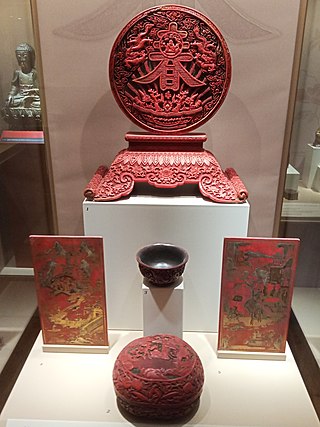
Lacquerware are objects decoratively covered with lacquer. Lacquerware includes small or large containers, tableware, a variety of small objects carried by people, and larger objects such as furniture and even coffins painted with lacquer. Before lacquering, the surface is sometimes painted with pictures, inlaid with shell and other materials, or carved. The lacquer can be dusted with gold or silver and given further decorative treatments.
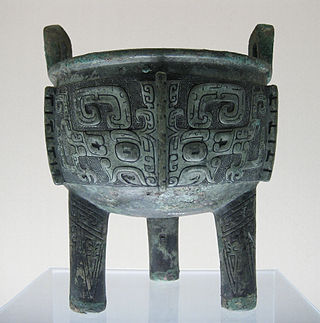
Ding are prehistoric and ancient Chinese cauldrons standing upon legs with a lid and two fancy facing handles. They are one of the most important shapes used in Chinese ritual bronzes. They were made in two shapes: round vessels with three legs and rectangular ones with four, the latter often called fāng dǐng "square ding (方鼎. They were used for cooking, storage, and ritual offerings to the gods or to ancestors.

The Museum of Contemporary Art San Diego (MCASD) is an art museum in La Jolla, California, focused on the collection, preservation, exhibition, and interpretation of works of art from 1950 to the present.

A guang or gong is a particular shape used in Chinese art for vessels, originally made as Chinese ritual bronzes in the Shang dynasty, and sometimes later in Chinese porcelain. They are a type of ewer which was used for pouring rice wine at ritual banquets, and often deposited as grave goods in high-status burial. Examples of the shape may be described as ewers, ritual wine vessels, wine pourers and similar terms, though all of these terms are also used of a number of other shapes, especially the smaller tripod jue and the larger zun.
Ancient Maya art comprises the visual arts of the Maya civilization, an eastern and south-eastern Mesoamerican culture made up of a great number of small kingdoms in present-day Mexico, Guatemala, Belize and Honduras. Many regional artistic traditions existed side by side, usually coinciding with the changing boundaries of Maya polities. This civilization took shape in the course of the later Preclassic Period, when the first cities and monumental architecture started to develop and the hieroglyphic script came into being. Its greatest artistic flowering occurred during the seven centuries of the Classic Period.

From c. 1650 BC, elaborately decorated bronze vessels were deposited as grave goods in the tombs of royalty and nobility during the Chinese Bronze Age. Documented excavations have found over 200 pieces in a single royal tomb. They were produced for an individual or social group to use in making ritual offerings of food and drink to his or their ancestors and other deities or spirits. Such ceremonies generally took place in family temples or ceremonial halls over tombs. These ceremonies can be seen as ritual banquets in which both living and dead members of a family were supposed to participate. Details of these ritual ceremonies are preserved through early literary records. On the death of the owner of a ritual bronze, it would often be placed in his tomb, so that he could continue to pay his respects in the afterlife; other examples were cast specifically as grave goods. Indeed, many surviving examples have been excavated from graves.

The Mingei International Museum is a non-profit public institution in Balboa Park in San Diego, California, that collects, conserves and exhibits folk art, craft and design. The museum was founded in 1974, and its building opened in 1978. The word mingei, meaning 'art of the people,' was coined by the Japanese scholar Dr. Sōetsu Yanagi by combining the Japanese words for all people and art.

A hu is a type of wine vessel that has a pear-shaped cross-section. Its body swells and flares into a narrow neck, creating S-shaped profile. While it is similar to you vessel, hu usually has a longer body and neck. The shape of hu probably derives from its ceramic prototype prior to the Shang dynasty. They usually have handles on the top or rings attached to each side of neck. Many extant hu lack lids while those excavated in such tombs as Fu Hao's indicate that this type of vessel might be originally made with lids. Although it is more often to see hu having a circular body, there also appears hu in square and flat rectangular forms, called fang hu and bian huArchived 2015-09-23 at the Wayback Machine in Chinese. In addition, hu often came to be found in a pair or in a set together with other types of vessels. As wine had played an important part in the Shang ritual, the hu vessel might be placed in the grave of an ancestor as part of ritual in order to ensure a good relationship with ancestor's spirit.

A jia is a ritual vessel type found in both pottery and bronze forms; it was used to hold libations of wine for the veneration of ancestors. It was made either with four legs or in the form of a tripod and included two pillar-like protrusions on the rim that were possibly used to suspend the vessel over heat. The earliest evidence of the Jia vessel type appears during the Neolithic Period. It was a prominent form during the Shang and early Western Zhou dynasties, but had disappeared by the mid-Western Zhou.

A dui is a type of Chinese ritual bronze vessel used in the late Zhou dynasty and the Warring States period of ancient China. It was a food container used as a ritual vessel. Most dui consist of two bowls supported on three legs.

A gui is a type of bowl-shaped ancient Chinese ritual bronze vessel used to hold offerings of food, probably mainly grain, for ancestral tombs. As with other shapes, the ritual bronzes followed early pottery versions for domestic use, and were recalled in later art in both metal, pottery, and sometimes stone. The shape changed somewhat over the centuries but constant characteristics are a circular form, with a rounded, wide, profile or shape from the side, standing on a narrower rim or foot. There are usually two, or sometimes four, handles, and there may be a cover or a square base.
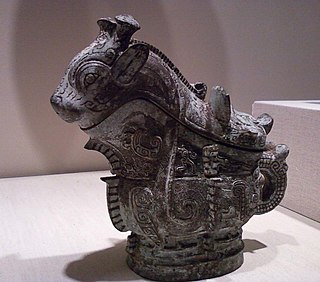
An elaborately decorated "ritual wine server" in the guang shape is a Chinese ritual bronze wine vessel, accession number 60.43, in the permanent Asian collection at the Indianapolis Museum of Art. It dates to about 1100 BCE in the Shang dynasty period. The piece is currently on display in the Arthur R. & Frances D. Baxter Gallery of the museum.

June Schwarcz was an American enamel artist who created tactile, expressive objects by applying technical mastery of her medium to vessel forms and plaques, which she considers non-functional sculpture.
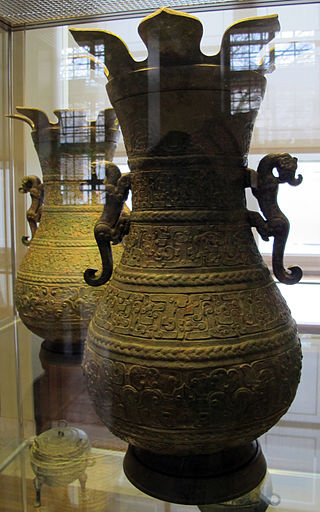
The Huixian Bronze Hu are a pair of bronze wine vessels that were found in the city of Huixian, Henan province, central China. Dating to the Eastern Zhou dynasty, they have been part of the British Museum's Asian Collections since 1972.

Margaret Noble is an American conceptual artist, sound artist, installation artist, teacher and electronic music composer.

The Minfanglei is an ancient Chinese bronze lei vessel from the late Shang dynasty or early Western Zhou dynasty. It is one of the largest of its kind, and called the "King of Fanglei". After its accidental discovery in 1919 in Hunan, its lid remained in China but the body was sold to collectors overseas, and set a world-record auction price for an Asian art work in 2001 when it fetched US $9.24 million. In 2014, a group of Chinese collectors bought it for a price between US $20 and 30 million, and donated it to the Hunan Museum, where it was reunited with its lid.

A fangyi is a type of Chinese ritual bronze container typical of the Shang and early to middle Zhou periods of Bronze Age China. It takes the shape of a square or rectangular casket with a cover that resembles a hip roof, surmounted by a knob of a similar hipped appearance. The lower edge is typically indented with a semi-circular notch.




